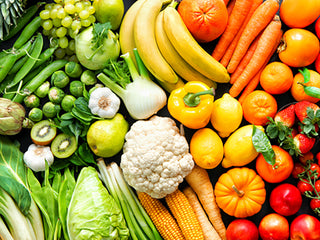What is the “Dirty Dozen”?
The Dirty Dozen is a list of the twelve fruits and vegetables that have been found to contain the most pesticide residues when tested. The list, which is released annually by the Environmental Working Group (EWG), is meant to inform consumers about which produce items they should consider purchasing organic to help minimise their exposure to chemicals.
The fruits and vegetables on the Dirty Dozen are considered “dirty” because they have been identified as having the highest levels of pesticide residue. If you buy these, you may be exposing yourself to more chemicals than if you opted for different fruits and vegetables or organically grown alternatives.
It is important to note that all food contains some traces of pesticides, so it is nearly impossible to completely eliminate them from your diet. However, there are a few ways to reduce your overall exposure.
Which fruits and vegetables are included in the “Dirty Dozen”?
The Environmental Working Group (EWG) releases an updated version of their list each year and this is based on data from fruit and vegetables tested in the USA.
In 2023, the Dirty Dozen from the EWG includes:
Strawberries, Spinach, Kale, Peaches, Pears, Nectarines, Apples, Grapes, Peppers, Cherries, Blueberries, and Green Beans
Pesticide Action Network UK also reports on the dirty dozen, but they use data released by the UK government. PAN UK takes into consideration the "cocktail" that is created when multiple chemicals are found on the same sample of fruits or vegetables. Their report is compiled from the most recent data (2021) and found the following fruits and vegetables to be the dirtiest:
Grapefruit, Grapes, Banana, Berries, Peppers, Raspberries, Spring greens and Kale, Melon, Beans, Aubergine, Broccoli, and Mushrooms
Why are these fruits and vegetables "dirty"?
The fruits and vegetables mentioned above are particularly vulnerable to contamination due to their thin skin, large surface area, and because they are frequently eaten without being washed or peeled.
Pesticides are known to be toxic to both people and the environment, so eating foods that have been exposed to them can come with an increased risk to our health. Eating these foods can also lead to an accumulation of toxins in the body over time, as well as contributing to environmental pollution.
What does this mean for our food and our environment?
The chemicals in pesticides may have adverse effects on our health, including but not limited to increased risk of cancer, birth defects, neurological damage, infertility, and even disruption of our endocrine systems.
Ultimately, the best way to avoid potential harm from pesticide exposure is to choose organic when shopping for fruits and vegetables. Organic options are more expensive and not always available – which is why knowing what the dirtiest dozen are can help us to make the best choices as consumers.
What else can we do?
- The fruit and vegetables that are being tested for pesticide exposure are available in supermarkets and grown in large industrial-scale operations, they are likely to be imported into the UK rather than grown here. So our first tip is to avoid buying the Dirty Dozen in conventional ways. Choose organic where possible and - if you can - find a local farmer’s market. Ask the grower what they use to protect their crops, some farmers choose to use physical barriers or natural deterrents to protect their crops from pests.
- If you do buy your fruits and veg at the supermarket, wash them thoroughly. Citrus fruits test very high for pesticides but this is mostly found on the skin of the fruit which we don’t typically consume. Additionally, cooking can help to break them down.
Some of the chemicals in pesticides are absorbed by the plant as it grows so washing and cooking won’t completely remove the residue, but it will reduce it.
- Avoid the dirtiest fruit and vegetables and lean into eating the cleaner options. The EWG also released a Clean 15, a list of produce that have the lowest levels of pesticides, but as this data is based on the USA, it’s hard to say what we should be eating more of in the UK.
Our advice is to think about how the fruit and vegetables are grown; are they normally grown in the UK like cabbages and carrots, do they have their own natural protective exteriors like pineapples or sweetcorn, are they less appealing to animals and insects like onions? If the answer is yes – farmers are less likely to need pesticides to get a good yield!
- One final way to ensure you know exactly what your fruit and vegetables have been treated with is to grow your own! Some of the dirty dozen can be grown in planters or small gardens; strawberries, green beans, and kale can all be grown in the UK in planters. A small strawberry patch (along with a bit of sun) can produce a good summertime crop.
A few natural ways to protect your homegrown produce include:
- Encouraging natural predators into your garden to feed on insects
- Using physical barriers, like copper wire or eggshells for slugs and netting for birds
- Companion planting, which is the method of planting brightly coloured – more appealing – plants around your crops to encourage pests to snack on them instead of your fruit and veg!


